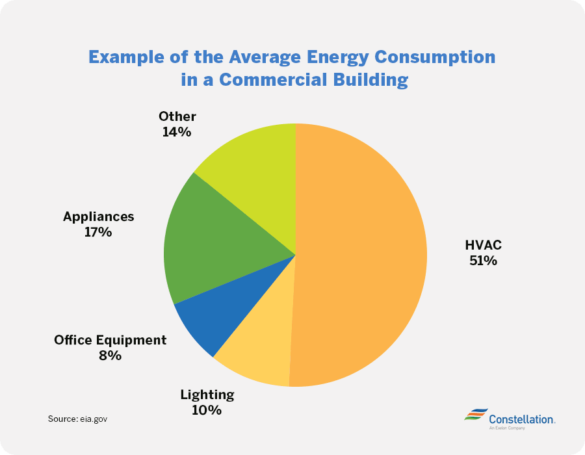Sustainability in commercial real estate is becoming increasingly important as businesses and tenants strive to reduce their environmental impact. From energy efficiency measures and water conservation initiatives to sustainable building materials and waste reduction strategies, there are a variety of ways that owners, agents, and tenants can work together to lower their carbon footprint.
In this blog post, we’ll explore how sustainability in commercial real estate works so that everyone involved can benefit from reduced environmental impacts.
Table of Contents
Energy Efficiency
Energy efficiency is an important way for commercial real estate owners, agents, and tenants to reduce their carbon footprint.
Investing in LED lighting can help lower energy costs while providing a brighter light than traditional bulbs. LEDs are also more durable and last longer, meaning they will need to be replaced less often.
Utilizing smart thermostats can also save money on energy bills by automatically adjusting the temperature when the building is not occupied or during peak hours of usage. Smart thermostats can also alert property managers if there are any issues with the heating or cooling system that needs attention.
Installing solar panels is another great way to reduce energy costs as well as your carbon footprint. Solar panels convert sunlight into electricity which can then be used to power various appliances within the building such as lights, air conditioning units, and computers. Not only does this provide clean renewable energy but it could potentially eliminate your entire energy bill!

(Source)
Water Conservation
Water conservation is another important part of achieving sustainability in commercial real estate. By making simple changes to the way water is used, property owners, agents, and tenants can help reduce their environmental impact while also saving money on utility bills.
One of the most effective ways to conserve water in a commercial property is by installing low-flow fixtures and appliances. Low-flow toilets, showerheads, and faucets use significantly less water than traditional models without sacrificing performance or comfort. This small change can result in significant savings over time as well as reduced strain on local resources.
Reusing greywater for irrigation and toilets is another great way to save both money and natural resources. Greywater is wastewater from sinks, showers, baths, and laundry machines that have been treated for flushing toilets or watering plants outside. Installing a greywater system allows businesses to take advantage of this free resource instead of relying solely on the municipal water supply.
Finally, rainwater collection systems are an excellent option for conserving water at commercial properties with large outdoor spaces such as parks or gardens. These systems capture rain runoff from rooftops or other surfaces before it enters storm drains, allowing the water to be reused for irrigation purposes.
Sustainable Building Materials
Sustainable building materials are an important part of reducing carbon footprint in a commercial space.
Recycled and reclaimed materials can be used in construction projects to reduce the need for new resources. Reclaimed wood from demolished buildings can be used for flooring, paneling, and furniture. Salvaged bricks and stones can also be reused in construction projects.
Low-VOC paints and finishes are another way to reduce environmental impact when constructing or renovating a property. VOC stands for volatile organic compounds which are chemicals that evaporate into the air at room temperature, potentially causing health problems such as headaches, nausea, eye irritation, and respiratory issues. Low-VOC paints contain fewer harmful chemicals than traditional paint products so they are safer for your occupants.
Finally, sustainable flooring options such as bamboo or cork should also be considered when selecting materials for a commercial real estate project. Bamboo is one of the best renewable sources of wood available since it grows quickly compared to other types of trees, making it more environmentally friendly than hardwood floors made from slow-growing species like oak or mahogany.
Cork is another great option because it’s naturally anti-microbial, which makes it ideal for high-traffic areas like lobbies or hallways where germs could easily spread.
Waste Reduction
Implementing recycling programs for tenants and employees is a great way to reduce waste. This can include providing bins for segregating trash in common areas or individual office cubicles. Having clear signage indicating what types of items should go in each bin will help ensure proper sorting of recyclables.
Additionally, offering incentives such as discounts on rent or services for participating in the program can encourage more people to properly segregate their trash.
Composting organic waste is another effective strategy for reducing waste. Composting helps break down food scraps into nutrient-rich soil which can then be used in gardens or landscaping projects around the property. If composting isn’t feasible on site due to space constraints, there are many companies that offer compost pickup services where they collect food scraps from businesses and take them to their own facilities where they process them into compost material.
Finally, reducing packaging when purchasing supplies and equipment is another way commercial real estate owners, agents, and tenants can reduce their carbon footprint. Whenever possible, opt for bulk purchases over individually packaged items to reduce the number of packaging materials needed as well as transportation costs associated with shipping multiple packages.
Additionally, look into reusable options such as cloth bags instead of plastic bags when shopping for office supplies so fewer resources need to be used overall.
Transportation Alternatives
Providing bicycle storage facilities is one of the most effective ways to encourage tenants and employees to bike instead of drive. Bicycle racks can be installed in parking lots or garages, providing a safe place for people to store their bikes while they’re at work or home.
Encouraging carpooling or ride-sharing is another great way to reduce emissions from transportation. Companies like Uber and Lyft have made it easier than ever for people to share rides with others who are going in the same direction. Carpooling not only reduces emissions but also saves money on gas costs as well as wear-and-tear on vehicles.
Offering public transportation incentives is another option if you want to reduce your carbon footprint from transportation. Many cities offer discounted bus passes or metro cards that allow commuters access at a reduced rate compared with regular fares. This encourages more people to take public transit rather than drive alone.
FAQs About Sustainability in Commercial Real Estate
What is sustainability in real estate?
Sustainability in real estate is the practice of designing, constructing, and operating buildings with consideration for their environmental impact.
How can commercial areas be sustainable?
- Install renewable energy systems.
- Purchase rainwater harvesting systems.
- Install sustainable weatherization materials.
- Add cool roofs.
- Utilize the modular construction method.
Conclusion
Overall, sustainability in commercial real estate is an important issue that all owners, agents, and tenants should be aware of. By taking steps to reduce their carbon footprint through energy efficiency, water conservation, sustainable building materials, waste reduction strategies, and transportation alternatives, they can help make a positive impact on the environment.
With the right knowledge and resources at hand, everyone involved in commercial real estate can do their part to create a more sustainable future for our planet.
{“@context”:”https:\/\/schema.org”,”@type”:”FAQPage”,”mainEntity”:[{“@type”:”Question”,”name”:”What is sustainability in real estate?”,”acceptedAnswer”:{“@type”:”Answer”,”text”:”
Sustainability in real estate is the practice of designing, constructing, and operating buildings with consideration for their environmental impact. “}},{“@type”:”Question”,”name”:”How can commercial areas be sustainable?”,”acceptedAnswer”:{“@type”:”Answer”,”text”:”
- \n\t
- Install renewable energy systems.\n\t
- Purchase rainwater harvesting systems.\n\t
- Install sustainable weatherization materials.\n\t
- Add cool roofs.\n\t
- Utilize the modular construction method.\n
- Install renewable energy systems.
- Purchase rainwater harvesting systems.
- Install sustainable weatherization materials.
- Add cool roofs.
- Utilize the modular construction method. “}}]}





